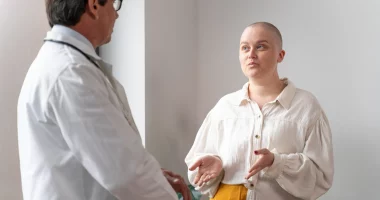Ankylosing spondylitis (AS) is a type of arthritis that mostly affects the lower back, spine, and joints where the spine connects to the pelvis. In the beginning, you might feel stiffness and pain in your lower back or hips, and these feelings might stick around for a few weeks or months.
AS is caused by inflammation in the body. This inflammation causes stiffness, and pain, and makes it hard to move your pelvis and spine.
The condition happens because of inflammation in the places where your tendons and ligaments connect to your spine and other joints. This inflammation can make extra bone grow in your spine, which can lead to your bones fusing together. In serious cases, this can even change the shape of your spine.
This article talks about AS, including what symptoms you might have, how doctors treat it, why it happens, what problems it might cause, and exercises that could help.
What is AS?
AS, short for ankylosing spondylitis, is a kind of arthritis that mainly affects the lower back and the joints where the spine connects to the hips.
It can be tricky for doctors to figure out if someone has AS, but it usually shows up with specific pain patterns, and changes can often be seen on X-ray and MRI pictures.
Boys and men might have more severe symptoms from the inflammation caused by AS, but sometimes girls and women with AS might not get diagnosed properly. The Spondylitis Association of America says that usually, people start having symptoms between 17 and 45 years old. However, kids and older adults can also develop symptoms.
While there isn’t a cure for AS yet, certain medicines can help with pain and swelling. Also, doing physical therapy exercises can make the pain feel better and might stop or slow down any problems with moving around.
Symptoms
AS starts with common symptoms like feeling stiffness and pain in your lower back or hips. This pain might stick around for weeks or months.
As time passes, these symptoms might spread to other parts of your spine and even affect your neck.
People with AS might feel:
- Pain in their spine and mid-back.
- Trouble moving around like they used to.
- Pain that gets worse when they rest or sleep, but feels better when they move.
- Fatigue, which means feeling tired and low on energy.
- Loss of appetite.
- Changes in their vision.
- Stomach pain and diarrhea.
- Difficulty taking deep breaths.
Some individuals might only have mild pain and go after some time, while others might have really bad and long-lasting pain. Everyone with AS might go through times when their symptoms get worse (called flares) and times when they feel better (called remission).
AS doesn’t just affect your spine. It can also cause problems around other joints in your body, like your ribs, shoulders, knees, ankles, and feet. It can even affect the tendons in your heel and the top part of your shin bone, as well as your Achilles tendon and sternum.
Causes
Doctors don’t know for sure why people get AS, but they think it’s because of inflammation in certain parts of the pelvis.
AS might happen because of a mix of things like genes and the environment. Some researchers think that if someone has certain genes, they might get AS after being exposed to something like a bacteria or virus.
Most people with AS, about 90%, have a gene called HLA-B27. It’s common for AS to run in families.
Some things might make it more likely for someone to get AS, like:
- Being 45 years old or younger.
- Having family members who have AS.
- Having other health issues like ulcerative colitis, Crohn’s disease, or psoriasis.
Diagnosis
Diagnosis of AS involves a series of steps carried out by a doctor. Initially, the doctor will inquire about the person’s signs and conduct a physical examination. If certain features of inflammatory back pain are present, it might suggest AS. These features include pain that doesn’t get better with rest, disrupts sleep, starts gradually between ages 17 and 45 without a clear injury, persists for months, is worse in the mornings but improves with activity, and responds positively to warm showers.
While imaging tests like X-rays and MRIs can help confirm AS, changes may not show up right away, leading to a delay in diagnosis. Blood tests are also essential in ruling out other possible causes. While there’s no single blood test that can confirm AS, doctors often look for a gene called HLA-B27, which is present in about 90% of individuals with AS. Other blood tests check for inflammation markers such as erythrocyte sedimentation rate (ESR) and C-reactive protein (CRP), as well as a complete blood count and chemistry.
Imaging tests, including X-rays, MRIs of the sacroiliac joints, and ultrasounds, are used to detect changes in the spine, pelvis, and peripheral joints, helping doctors confirm an AS diagnosis.
Treatment
Treatment for AS aims to manage symptoms and slow down the progression of the condition, as there’s currently no cure available.
Various treatment options are available, including occupational therapy, physical therapy, and specific exercises tailored to individual needs. Additionally, certain medications can help relieve pain and reduce inflammation. In rare cases where AS leads to severe deformities or joint damage, surgery might be recommended. However, surgery is typically considered only when other treatments have not been effective, and it often involves collaboration between rheumatologists and orthopedic surgeons.
People diagnosed with AS usually need ongoing medical care from a rheumatologist or a doctor specialized in treating arthritis and related conditions. Since AS increases slowly, regular visits to the doctor are essential for monitoring the condition’s progression and adjusting treatment plans accordingly. This consistent medical care ensures that symptoms are managed effectively and any potential complications are addressed promptly.
Complications
AS can lead to various complications that affect different parts of the body. One common complication is eye inflammation, known as uveitis or iritis, which can cause pain and redness and, if left untreated, may impair vision.
In most cases, AS can lead to the vertebrae of the spine to fuse together, a process called ankylosis. This fusion can make everyday actions challenging and may also cause curvature of the spine, even though advancements in treatment have made this less common nowadays.
Additionally, AS can restrict chest movement, making breathing difficult, and increase the chance of osteoporosis and fractures, particularly in the back. Long-term AS or fused bones can further elevate the risk of fractures.
Some people with AS may also face jaw inflammation, it is hard to open their mouths to eat, while others may develop inflammatory bowel disease (IBD). Rarer complications include aortic regurgitation, pulmonary fibrosis, and cauda equina syndrome, which can severely compress nerves in the back.
Living with AS symptoms and chronic pain can also take a toll on mental health, potentially leading to depression and other mental disorders. Regular monitoring and appropriate treatment are essential in managing these complications and improving the overall quality of life for individuals with AS.
Exercises
Physical exercise can assist in managing symptoms and stop or delay problems with moving around.
A physical therapist can create a program to assist someone keep good posture and move their joints properly. This program might include:
- Daily exercises
- Special training for specific problem areas
- Therapeutic exercises
There are two main types of physical therapy exercises:
- Strengthening exercises: These build muscle strength.
- Range-of-motion exercises: These helps maintain joint flexibility.
The Social Security Administration (SSA) says a good exercise program should have four key parts:
- Stretching: It makes muscles more flexible and less stiff, reducing swelling and pain. It also lowers the risk of joints becoming permanently stiff.
- Cardiovascular exercises: Activities like walking and swimming improve heart and lung health, and reduce pain and tiredness.
- Muscle exercises: Strengthening the muscles around the core and back helps support the spine, improves posture and movement, and reduces pain.
- Balance training: This improves stability and lowers the risk of falling.
Doctors might also suggest water or swimming exercises if a person can use a pool. These activities help keep flexibility and are safer for people at risk of injury.
Diet
Doctors might suggest certain foods, nutrients, or diets to help manage the symptoms of Ankylosing Spondylitis (AS). This can include:
- Anti-inflammatory diet: Eating whole foods, like those in the Mediterranean diet, can help reduce inflammation.
- Weight loss: If necessary, losing weight can lessen the pressure on bones and joints.
- Avoiding inflammatory foods: Cutting out ultra-processed foods that can cause more inflammation.
More investigation is required to fully understand how specific diets can benefit people with AS.
Summary
Ankylosing Spondylitis (AS) is a kind of arthritis that specifically affects the lower back and spine. It usually starts in the late teenage years or early adulthood.
There is no cure for AS, but many treatments can assist slow down or stopping its progression. Managing the condition every day, such as through a regular exercise program, can assist people to control their signs and improve their quality of life.








